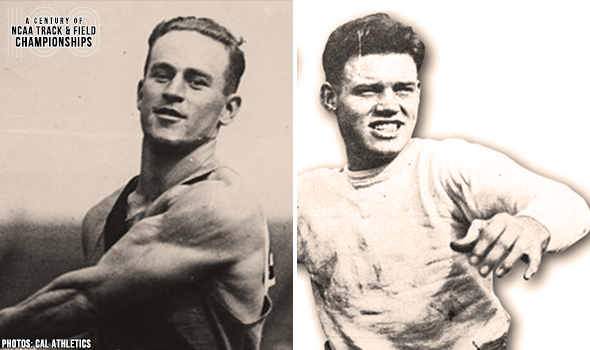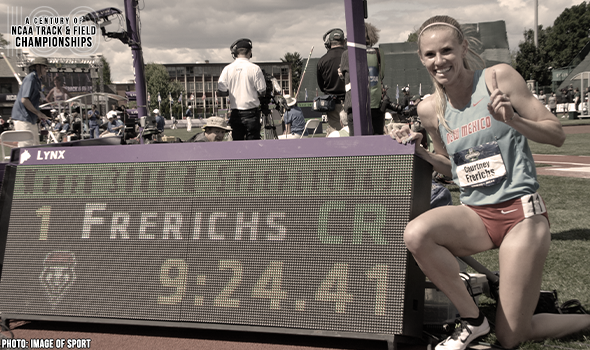
Merchant, Muller Led Cal’s Field Day In 1922
Cal had a literal field day in 1922.
As great as the inaugural NCAA Outdoor Track & Field Championships were in 1921, the second event was bigger — and arguably, even better.
The 1922 edition had something the 1921 version didn’t – the California Golden Bears, hot off a second-straight win at the powerful IC4A Championships (Cal was the first non-East Coast program to win the meet in 1921).
The Bears scored all but three of their then-record 281⁄18 points in all seven field events (The triple jump was not yet on the program and would only be held five times between 1932 and 1956, before becoming an annual event in 1959). They were led by a pair of three-event scorers – both in combinations that displayed exceptional and unusual athletic ability.
Jack Merchant – a 1920 Olympian in the long jump – won NCAA titles in the shot and hammer, the latter being the event in which he would compete at the 1924 Olympics. He added points in the long jump, placing fourth when all field events were contested on the same day.
Merchant, who was a graduate of the same Marshfield High School in Coos Bay, Oregon (formerly known as Marshfield, Oregon) as eventual distance legend Steve Prefontaine, scored a team-high 11 points at the 1922 NCAA meet. To wit, scoring was on a 5-3-2-1-½ system back then; Merchant’s performance would be worth 25 points on the current scoring system, a meet total that wouldn’t be surpassed until Jesse Owens racked up 40 in back-to-back years in 1935 and 1936.
Cal’s other point-scoring machine was Harold “Brick” Muller (He was commonly called “Brick” because of the red color of his hair). Born near the Oregon border in Dunsmuir, California, Muller grew up in San Diego and went to Cal as a football player (He was MVP for the Bears’ “Wonder Team” in their 28-0 win over Ohio State in the 1921 Rose Bowl).
Muller was as versatile as Merchant in track & field — and actually more accomplished internationally, earning the silver medal at the 1920 Olympics in the high jump. In the 1922 NCAA meet, Muller’s best finish was in the long jump where he took second over Merchant’s aforementioned fourth. Muller also added points in the high jump (third) and discus (fourth).
After playing and coaching football – notably at the same time for the Los Angeles Buccaneers in their only season in the NFL in 1926 – Muller would also go to a second Olympics, but not until 1956 as head team physician.
Cal nearly won that 1922 NCAA meet just with Merchant and Muller. After all, runner-up Penn State’s 19½ points were the only total higher than the 17 combined points from the Bear duo. Cal also had five more scorers in the meet to turn away the Nittany Lions: Allen Norris tied for first in the pole vault; Harry McDonald finished second in the 440 as the team’s only scorer on the track; Jack Witter took third in the shot; Sandy Sorrenti was third in the javelin; Ted Treyer ended up in a nine-way tie for fifth in the high jump, which helps explain the fractions.
The NCAA and collegiate track & field will mark a momentous milestone in the spring of 2021 -- the 100th anniversary of the NCAA Championships and with that, the NCAA Track & Field Championships. In June 1921, the University of Chicago hosted the first track & field championships in NCAA history.
This point can’t be emphasized enough: Not only was the event the first for NCAA track & field, but the first championships for any sport under the sponsorship of the NCAA.
To celebrate, over each of the next 365 days, the U.S. Track & Field and Cross Country Coaches Association (USTFCCCA) will celebrate moments, student-athletes, and coaches that have made a century’s worth of championships special. From humble beginnings to important historical milestones to the modern-day, collegiate track & field has evolved with the American society.
The 2021 edition of the NCAA Division I Outdoor Track & Field Championships begin with preliminary round action on May 27-29 in Jacksonville, Fla., and College Station, Texas. The championships final site and culmination of the celebration is slated for June 9-12, 2021 at the newly rebuilt Hayward Field in Eugene, Ore.

Sternberg Reached New Heights In 1963
Brian Sternberg won the pole vault title at the 1963 NCAA Outdoor Track & Field Championships. He was the first athlete to clear 16 feet in meet history at 4.97m (16-3¾).

Williams Went Back-To-Back With CR In 1996
Tonya Williams won back-to-back 400H titles at the NCAA DI Outdoor T&F Championships in 1995 & 1996. She set a CR of 54.56 in 1996 & won by 0.35 seconds.

Kimobwa Ran Into Record Book In 1977
Samson Kimobwa set a MR in the 10K of 28:10.27 at the 1977 NCAA DI Outdoor T&F Championships. He won by 12.21 seconds in a race that saw the top-2 finishers under previous meet record.

Florida’s Taylor Set All-Conditions TJ Best In 2011
Christian Taylor set an all-conditions meet best in the triple jump of 17.80m (58-4¾) at the 2011 NCAA DI Outdoor T&F Championships. Taylor also won the TJ crown in 2010.

Johnson Led 1-2-3 HJ Sweep By Arizona In 1985
Katrena Johnson led a 1-2-3 finish by Arizona athletes in the high jump at the 1985 NCAA DI Outdoor T&F Championships. Johnson cleared 1.94m (6-4¼) to set a collegiate record.

Fresno State’s Robinson Equaled WR In 1957
Ancel Robinson equaled the world record in the 220H of 22.2 at the 1957 NCAA Outdoor T&F Championships. He also matched the American record & collegiate record.

Johnson Set 1500 MR After Thrilling Duel
Sinclaire Johnson set a meet record in the 1500 of 4:05.98 at the 2019 NCAA DI Outdoor T&F Championships. Johnson won an epic duel against Jessica Hull of Oregon.

Bohni Soared To Pole Vault MR In 1983
Felix Bohni set a meet record in the pole vault of 5.55m (18‑2½) at the 1983 NCAA DI Outdoor T&F Championships. Bohni was one of three men to top 18 feet.

Frerichs Broke Steeplechase Records In 2016
Courtney Frerichs set a collegiate record in the steeplechase of 9:24.41 at the 2016 NCAA DI Outdoor T&F Championships. Frerichs won by the second largest margin in meet history.

URI’s Black Rolled To NCAA’s 1st 10K Title
Robert Black won the first 10,000-meter title ever awarded at the NCAA Outdoor Track & Field Championships in 1948. Black crossed the finish line in 32:13.5, 48 seconds ahead of the runner-up.

